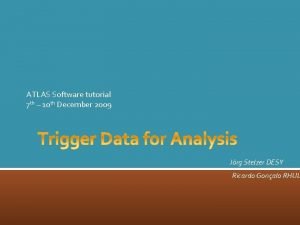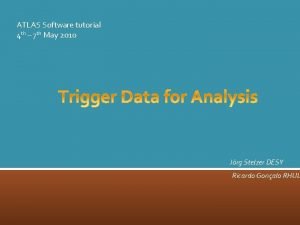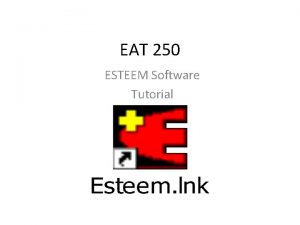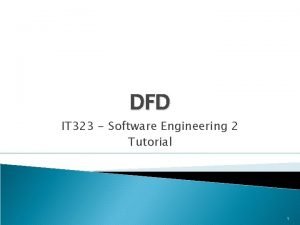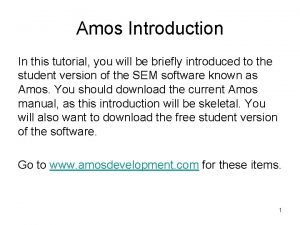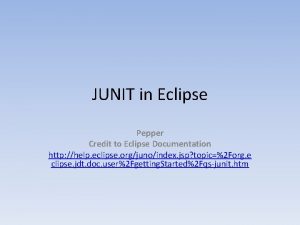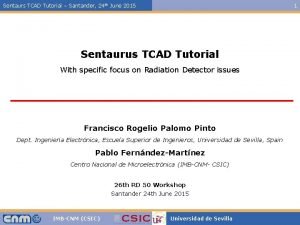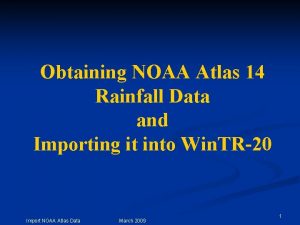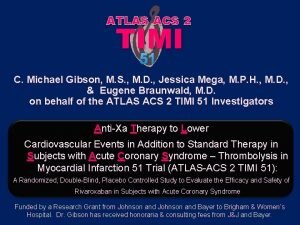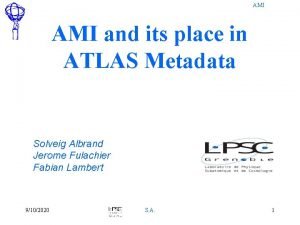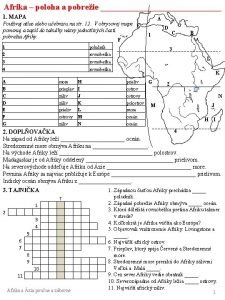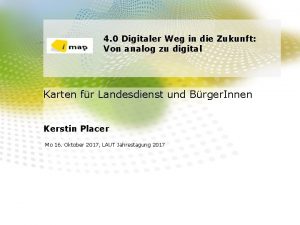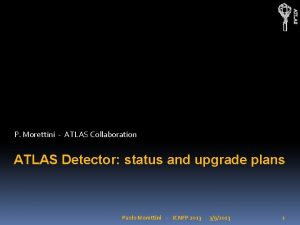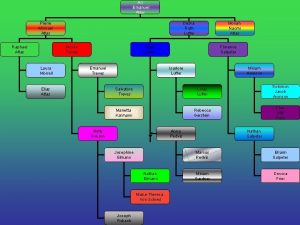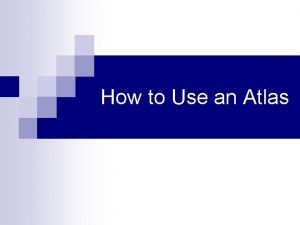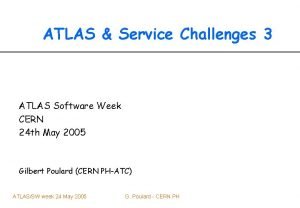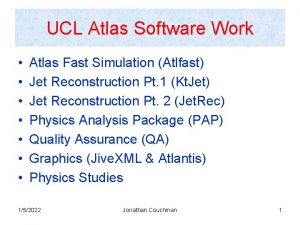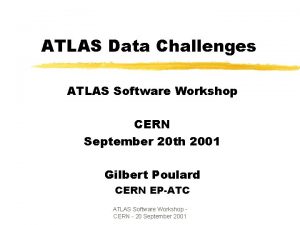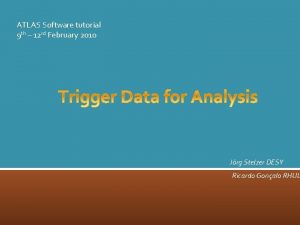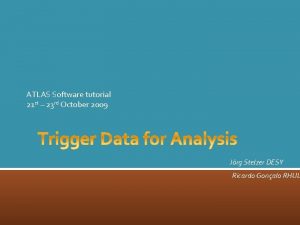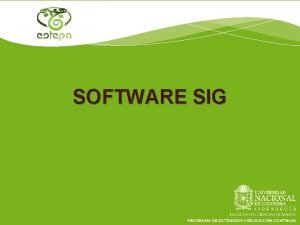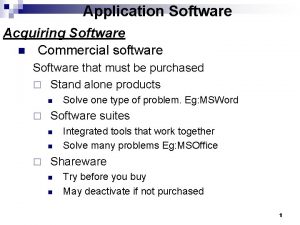ATLAS Software tutorial 4 th 7 th May





































- Slides: 37

ATLAS Software tutorial 4 th – 7 th May 2010 Jörg Stelzer DESY Ricardo Gonçalo RHUL

The Trigger EM ROI L 2 calorim. An example Electromagnetic clusters Level 1: Region of Interest is found and position in EM calorimeter is passed to Level 2 cluster? L 2 tracking track? Level 2 seeded by Level 1 • Fast reconstruction algorithms • Reconstruction within Ro. I match? E. F. calorim. E. F. tracking Ev. Filter seeded by Level 2 • Offline reconstruction algorithms • Refined alignment and calibration ATLAS Software Tutorial ‐ Trigger Data track? e/ reconst. e/ OK? 2

The Trigger Execution FEX algo’s are executed to create Feature features on which selection in HYPO algo’s is based FEX � Chain: Started, if seed has fired and chain is not Stopped , if a HYPO is not passed Last HYPO passed � � � Passed, if at least one EF chain is passed Put into all streams that are associated with the passed EF chains Trigger objects associated with triggers through Navigation Trigger. Elements Trigger information in + Navigation EM ROI L 2 calorim. TE Pass/Fail cluster? EM_ROI Trig. EMCluster L 2 tracking track? Trig. In. Det. Tracks match? Event: EM ROI ESD AOD DPD TAG + Configuration + E. F. calorim. TE Pass/Fail E. F. tracking TE Pass/Fail track? e/ reconst. TE Pass/Fail γ OK? e OK? Calo. Cluster EFTrack egamma Feature ATLAS Software Tutorial ‐ Trigger Data 3

s ure nfig Co Trigger. DB All configuration data S de to r Tr cod es M igg ed en er u Trigger Configuration + Data Trigger Result • passed? , passed through? , prescaled? , last successful step in trigger execution? • Trigger objects for trigger selection studies Trigger Configuration AOD DPD • Trigger names, prescales, pass throughs access through Trig. Decision. Tool ATLAS Software Tutorial ‐ Trigger Data TAG With decreasing amount of detail Trigger EDM ESD 4

Trigger-Aware Analysis – Introductory Comments � Analysis based on single trigger chain or an ‘OR’ of a few chains (a ‘Chain. Group’) � Chain definition – algorithms, cuts, multiplicities – do not change during a run, but can change between runs Important for analysis on DPD, where multiple runs are merged, check the Chain. Group content between each run � Prescales at LVL 1 and at HLT can change between luminosity blocks A negative prescale means that this trigger is off. This is important for calculating the integrated luminosity. Check each luminosity block. ATLAS Software Tutorial ‐ Trigger Data 5

What’s there? – Trigger Decision �Lvl 1 decision after dead‐time veto �HLT decision, information for pass‐through’ed and for resurrected triggers �Bunch groups that fired �For more detailed studies: Lvl 1 decision before prescale, before veto Error codes for HLT‐algorithms Last step of chain execution ATLAS Software Tutorial ‐ Trigger Data 6

Bringing it Together – Trig. Decision. Tool ESD AOD DPD contain persistent Decision + Navigation Unpacking Dec. + Nav. EDM P/T convertion Upon Request Transient: Trig. Decision Feature Nav. Configuration IOV based P/T conv. IOVDb. Svc Configuration Trig. Decision. Tool ATLAS Software Tutorial ‐ Trigger Data 7

Tool Usage 1. Alg. h: define Tool. Handle to a private: Tool. Handle<Trig: : Trig. Decision. Tool> tdt; 2. Alg. cxx – Alg: : Alg(): declare My. Algo: : My. Algo(const std: : string &name, …) tdt("Trig: : Trig. Decision. Tool/Trig. Decision. Tool”) {…} 3. Alg. cxx – Alg: : initialize(): retrieve Status. Code sc = tdt. retrieve(); Trig. Decision. Tool. Handle as public tool Has to be in initialize()! 4. Alg. cxx – Alg: : execute(): use tool TWIKI: Doxygen: if (tdt->is. Passed (“L 2_e 15 i”)) { log << MSG: : INFO << ”I’m happy!“ << endreq; } https: //twiki. cern. ch/twiki/bin/view/Atlas/Trig. Decision. Tool 15 http: //atlas‐computing. web. cern. ch/. . . /Trig. Decision. Tool/html/ ATLAS Software Tutorial ‐ Trigger Data 8

Working with Chain. Groups 1. Alg. h: define Chain. Group pointer 2. Alg. cxx – Alg: : initialize(): declare Chain. Group Note: the Chain. Group automatically const Trig: : Chain. Group* m. My. Trigger; m. My. Trigger = tdt. create. Chain. Group(“EF_e 10_loose”, ”EF_mu 10”, . . . ); updates with each run (chain content) and lumiblock (prescales) Use regular expressions, e. g. “EF_e. *” 3. Alg. cxx – Alg: : execute(): Access to trigger configuration bool use. LB = ! m. My. Trigger->get. List. Of. Triggers(). empty(); bool my. Event = m. My. Trigger. is. Passed(); Access to trigger decision const Trig: : Feature. Container fc = m. My. Trigger. features(); const std: : vector< Trig: : Feature< Trig. Tau > > taus = fc. get(); Access to trigger objects Anonymous Chain. Groups: Note that one can work without steps 1 and 2. In Alg: : execute() define the triggers on the fly: • Equally fast (TDT keeps Chain. Groups) • string tr (“EF_e 10_loose”); bool use. LB = ! tdt->get. List. Of. Triggers(). empty(tr); bool my. Event = tdt->is. Passed(tr); const Trig: : Feature. Container fc = tdt. features(tr); ATLAS Software Tutorial ‐ Trigger Data 9

What’s there? – Features and Navigation � Access to features through the “Trigger. Navigation” � Features are created by FEX algorithms, they appear in Store. Gate. A FEX also creates a “Trigger. Element” (TE) A TE is used as handle to the feature A TE has a pass/fail state set by the corresponding HYPO � The navigation gives you all the features that were created in a chain Or just those that were successful (features in ROI’s which passed all cuts) – that is the default! Can also give you combinations of features (for multi‐object triggers) Ancestor function to navigate, e. g. from electron to track and cluster ATLAS Software Tutorial ‐ Trigger Data 10

Athena Example for using Features Feature. Container for ‘EF_tau 16 i_loose_2 j 23’ Access the feature You need to know the type of the Feature: ‘Jet. Collection’ in EF Access the object (implicit conversion) Access information of object Find corresponding L 2 jet using TDT: : ancestor<T> Feature. Container f = tdt->features("EF_tau 16 i_loose_2 j 23"); // creating the feature container std: : vector< Feature<Jet. Collection> > jet. Colls = f. get<Jet. Collection>(); m. Log << MSG: : INFO << "Number of Jet. Collections: " << jet. Colls. size() << endreq; if(jet. Colls. size()>0) { const Feature<Jet. Collection>& jcf = jet. Colls[0]; // get the first Feature m. Log << MSG: : INFO << "Label: " << jcf. label() << endreq; const Jet. Collection* jc = jcf; // implicit Feature -> object conversion m. Log << MSG: : INFO << "Number of Jets: " << jc->size() << endreq; Jet. Collection: : const_iterator j. It = jc->begin(); for (; j. It != jc->end(); ++j. It ) { Jet* jet = *j. It; m. Log << MSG: : INFO << "Jet e : " << jet->e() << endreq; } // find the corresponding jets in Lvl 2 through the inheritance tree (navigation does that all) Feature<Trig. T 2 Jet> l 2 jet. F = tdt->ancestor<Trig. T 2 Jet>(jcf); m. Log << MSG: : INFO<<"Found “<< (l 2 jet. F. empty()? "no ": "“)<< "corresponding L 2 Jet. ”<<endreq; Output: Number of Jet. Collections: 1 TE Label: Trig. Jet. Rec Number of Jets: 1 Jet e : 82827. 9 Found corresponding L 2 Jet. e : 83197. 4 if ( !l 2 jet. F. empty() ) { const Trig. T 2 Jet* t 2 jet = l 2 jet. F. cptr(); // explicit Feature -> object conversion m. Log << MSG: : INFO << " e : " << t 2 jet->e() << endreq; } } ATLAS Software Tutorial ‐ Trigger Data 11

Trigger Object Matching � Why? Some analyses require object level trigger information: Tag and Probe Some analyses have multiple objects of same type and need matching for detailed efficiency estimation Trigger selection design and optimisation Matching framework available in Trigger/Trig. Analysis/Trig. Object. Matching package in release 15. 3. 0 and later � Examples available in Trigger/Trig. Analysis. Examples in release 15. 4. 0 and later � Trig. Match. Ex. Alg ‐ Athena example of matching for each common offline type Trig. Match. Example. ARA ‐ Example of trigger matching in ARA Tag. And. Probe. Ex. Alg ‐ Athena example of tag and probe analysis with trigger matching � TWiki available with detailed information for users and developers https: //twiki. cern. ch/twiki/bin/view/Atlas/Trigger. Objects. Matching ATLAS Software Tutorial ‐ Trigger Data 12

What’s there? – Configuration Data �L 1 Items: name, prescale For more detailed studies: version, CTP‐Id, bunch group, thresholds and multiplicities �HLT Chains: name, level, prescale, streams For more detailed studies: version, counter, trigger elements and multiplicities �Trigger Release, configuration keys (useful for lookup in the Trigger. DB) No access with the TDT, but check. Config. Trigger. py ATLAS Software Tutorial ‐ Trigger Data 13

Configuration Access with the TDT std: : vector< std: : string > > float � get. List. Of. Triggers (const Trig: : Chain. Group *chaingroup) const List of trigger names of the Chain. Group chaingroup get. List. Of. Streams (const Trig: : Chain. Group *chaingroup) const List of stream names of the Chain. Group chaingroup get. List. Of. Trigger. Elements (const Trig: : Chain. Group *chaingroup) const List of lists of TE names in Chain. Group chaingroup. Inner vectors are for a single trigger step, the length of those is the trigger multiplicity. get. Prescale (const Trig: : Chain. Group *chaingroup, unsigned int condition=Trig. Defs: : Physics) const Prescale of the Chain. Group chaingroup. All methods come with two flavors, argument: const Trig: : Chain. Group *chaingroup const std: : string &trigger. Names=“. *” Here the Chain. Group is created on the fly from the pattern ‘trigger. Names’ (regexp ‐ “. *” means ‘all’) � All functions are forwarded from Chain. Group, tdt‐>fnc(chgr, …) is equivalent to ch. Gr‐>fnc(…) � Prescales: For single triggers the prescale combined for all levels is returned. If a multi‐ trigger Chain. Group contains an unprescaled trigger, the return value is 1. It is 0 otherwise. ATLAS Software Tutorial ‐ Trigger Data 14

Tools to Investige the Trigger Setup � http: //atlas‐trigconf. cern. ch: Main web portal to trigger configuration by run number, MC menu name, configuration keys Uses Trigger. Tool and Atl. Cool. Trigger. py underneath � Trigger. Tool: Java based GUI to browse the Trigger. DB (replica) for all information Also used at point 1 for preparation of trigger � Atl. Cool. Trigger. py: Command line tool to show release, configuration keys, menu information, streams for data � http: //atlas‐runquery. cern. ch/ Query page for trigger chains, prescales, trigger release for data ATLAS Software Tutorial ‐ Trigger Data 15

Example for the Configuration Portal � Go to http: //atlas‐trigconf. cern. ch 3. Browse the trigger configuration (definition, algorithms, selection cuts) 1. Enter run-range 2. Click on link in resulting run list Also with simple comparison functionality ATLAS Software Tutorial ‐ Trigger Data 16

Trigger Menu Listing �Trigger Menu and L 1 rates stored in COOL, HLT rates coming. Quick access via Atl. Cool. Trigger. py (command line tool) ▪ Atl. Cool. Trigger. py –r 91000‐ 99000 (many run summary) ▪ Atl. Cool. Trigger –v –m –r 90272 (single run menu) ▪ Prints keys, trigger menus, streams, allows diff‐ing of menus in different runs, creates menu in xml format Run summary pages (WEB based): http: //atlas-service-dbrunlist. web. cern. ch/atlas-service-db-runlist/query. html ▪ Trigger names, rates for single run ATLAS Software Tutorial ‐ Trigger Data 17

Trigger. Tool � Java based front end to Trigger. DB, launch from the web (Java web‐start): http: //www. cern. ch/triggertool Overview of all trigger configurations (data taking and MC) Detailed and convenient investigation of trigger menus ▪ Trigger definition L 1‐>L 2‐>EF: prescales, threshold algorithms, selection criteria, streaming information, etc. � Possibility to compare different trigger configurations Used at point 1 for trigger operation � TDAQ training tutorial for the TT � ATLAS Software Tutorial ‐ Trigger Data 18

Scripts to Check Pool File Content � check. Trigger. py AOD. pool. root Runs over ESD/AOD/DPD and presents detailed (chain‐wise) counts of the trigger decision � check. Trigger. Config. py ‐d AOD. pool. root File: AOD. pool. root Size: 55955. 492 kb Nbr Events: 250 Trigger configuration summary: SMK: 0, HLTpsk: 0, L 1 psk: 0 Config source: Trigger. Menu. XML/LVL 1 config_MC_lumi 1 E 31_no_prescale_15. 1. 0. xml and Trigger. Menu. XML/HLTconfig_MC_lumi 1 E 31_no_prescale_15. 1. 0. xml L 1 Items : 146 HLT Chains : 556 ======================================== ID level Trigger name Passed events: raw, after PS, after PT/Veto ======================================== LVL 1 Global LVL 1 250 LVL 2 Global LVL 2 250 EF Global EF (LVL 3) 250 ‐‐‐‐‐‐‐‐‐‐‐‐‐‐‐‐‐‐‐‐‐‐‐‐‐‐‐‐‐‐‐‐‐‐‐‐‐‐‐‐ 13 LVL 1 L 1_2 EM 13 71 14 LVL 1 L 1_2 EM 13 I 34 163 LVL 1 L 1_2 EM 13_MU 6 8 8. . ‐‐‐‐‐‐‐‐‐‐‐‐‐‐‐‐‐‐‐‐‐‐‐‐‐‐‐‐‐‐‐‐‐‐‐‐‐‐‐‐. . . 77 LVL 2 L 2_2 g 10 118 246 LVL 2 L 2_2 g 10_mu 6 12. . ‐‐‐‐‐‐‐‐‐‐‐‐‐‐‐‐‐‐‐‐‐‐‐‐‐‐‐‐‐‐‐‐‐‐‐‐‐‐‐‐. . . 477 EF_2 e 6_medium 8 8 478 EF_2 e 6_medium 1 7 7 79 EF_2 g 20 39 248 EF_2 j 42_xe 30 3 3. . ======================================== Runs on ESD/AOD/DPD and presents detailed trigger configuration(s) Shows multiple configurations (merged DPD) > check. Trigger. Config. py –d data 09_cos. 00121733. physics_L 1 Calo. recon. ESD. r 733_tid 073522/ESD. 073522. _000001. pool. root. 1 … EF: EF_mu 0_tgc_halo_IDSCAN (1. 00), L 2: L 2_mu 0_tgc_halo_IDSCAN (1. 00), L 1: L 1_MU 0_TGC_HALO (1) [streams: TGCw. Beam] … ATLAS Software Tutorial ‐ Trigger Data 19

Summary � Trigger data access in Athena, ARA, C++, or python with the Trig. Decision. Tool! Many examples, plus a large number of people to provide help when needed (hn‐atlas‐Trigger. Help at cern. ch) � Tools to check the trigger information for given run Configuration: Trigger. Tool or http: //atlas‐trigconf. cern. ch Pool files: check. Trigger. py and check. Trigger. Config. py � Prescales to be checked for each lumiblock luminosity Remember that negative prescale means trigger did not run � Important for analysis: matching of offline reconstruction and trigger objects ATLAS Software Tutorial ‐ Trigger Data 20

Additional Information Trigger user info: Tutorials: https: //twiki. cern. ch/twiki/bin/view/Atlas/Trigger. User. Pages https: //twiki. cern. ch/twiki/bin/view/Atlas/Trigger. Software. Tutorial. Page TDT Twiki: TDT Doxygen: https: //twiki. cern. ch/twiki/bin/view/Atlas/Trig. Decision. Tool http: //atlas‐computing. web. cern. ch/atlas‐ computing/links/nightly. Dev. Directory/Atlas. Offline/latest_doxygen/Install. Area/doc//T rig. Decision. Tool/html/index. html https: //twiki. cern. ch/twiki/bin/view/Atlas/Trigger. Objects. Matching Trigger obj matching: Trig. Analysis. Example: http: //atlas‐computing. web. cern. ch/atlas‐ computing/links/nightly. Dev. Directory/Atlas. Offline/latest_doxygen/Install. Area/doc/Tr ig. Analysis. Examples/html/index. html User. Analysis example: https: //twiki. cern. ch/twiki/bin/view/Atlas. Protected/User. Analysis Trigger Configuration: Trigger. Tool: Run query: Trigger EDM: http: //trigconf. cern. ch http: //www. cern. ch/triggertool http: //atlas‐runquery. cern. ch/ https: //twiki. cern. ch/twiki/bin/view/Atlas/Trigger. EDM, http: //alxr. usatlas. bnl. gov/lxr/source/atlas/Trigger/Trig. Event. ARA/Trig. Even t. ARA/selection. xml Trigger. Menu group: Trigger. SW group: Trigger. Config group: https: //twiki. cern. ch/twiki/bin/view/Atlas/Trigger. Physics. Menu https: //twiki. cern. ch/twiki/bin/view/Atlas/TAPMCore. SW https: //twiki. cern. ch/twiki/bin/view/Atlas/Trigger. Configuration Help on e‐groups: hn‐atlas‐Trigger. Help at cern. ch ATLAS Software Tutorial ‐ Trigger Data 21

Details On the issues described above ATLAS Software Tutorial ‐ Trigger Data 22

Trigger Content of Atlas-Runquery � Search for runs by release, configuration key, trigger content � Display and have links to run‐summary, AMI, trigconf. ch, e‐log ATLAS Software Tutorial ‐ Trigger Data 23

What’s there? – Trigger Decision �Lvl 1 decision after dead‐time veto �HLT decision, information for pass‐through’ed and for resurrected triggers �Bunch groups that fired �For more detailed studies: Lvl 1 decision before prescale, before veto Error codes for HLT‐algorithms Last step of chain execution ATLAS Software Tutorial ‐ Trigger Data 24

Decision Access with the TDT bool is. Passed (const Trig: : Chain. Group *chaingroup, unsigned int condition=Trig. Defs: : Physics) const true if given group of chains passed char get. BGCode () const Get the bunch group code byte. BG X fired (X=0. . 7): get. BGCode() & (0 x 1<<X) All trigger decisions through “is. Passed()”, behavior depends on “condition” argument: � Trig. Defs: : Physics: [default] � � Pseudonym for require. Decision | enforce. Logical. Flow, which means that both conditions are applied. Default for is. Passed() and for get. Prescale(). Trig. Defs: : enforce. Logical. Flow, Trig. Defs: : full. Chain: combination of all three trigger levels. A decision must have been made, pass due to pass-through or resurrection is not enough. Event was passed through. A trigger chain can have a pass‐through factor in order to record events independent of the decision. This is useful for understanding the trigger behavior. Restrict the is. Passed() to those events, require. Decision must be off. Trig. Defs: : require. Decision: Trig. Defs: : passed. Through: Trig. Defs: : allow. Resurrected. Decision: If a trigger is prescaled on a given event, that trigger chain is not executed. If that event is accepted it is often important to know also the trigger decision and features of the prescaled trigger (orthogonal triggers for efficiency determination. ) For a fraction of these cases we execute the trigger and safe its decision. This is accessed with allow. Resurrected. Decision (require. Decision must be off. ) ATLAS Software Tutorial ‐ Trigger Data 25

What’s there? – Configuration Data �L 1 Items: name, prescale For more detailed studies: version, CTP‐Id, bunch group, thresholds and multiplicities �HLT Chains: name, level, prescale, streams For more detailed studies: version, counter, trigger elements and multiplicities �Trigger Release, configuration keys (useful for lookup in the Trigger. DB) No access with the TDT, but check. Config. Trigger. py ATLAS Software Tutorial ‐ Trigger Data 26

Configuration Access with the TDT std: : vector< std: : string > > float � get. List. Of. Triggers (const Trig: : Chain. Group *chaingroup) const List of trigger names of the Chain. Group chaingroup get. List. Of. Streams (const Trig: : Chain. Group *chaingroup) const List of stream names of the Chain. Group chaingroup get. List. Of. Trigger. Elements (const Trig: : Chain. Group *chaingroup) const List of lists of TE names in Chain. Group chaingroup. Inner vectors are for a single trigger step, the length of those is the trigger multiplicity. get. Prescale (const Trig: : Chain. Group *chaingroup, unsigned int condition=Trig. Defs: : Physics) const Prescale of the Chain. Group chaingroup. All methods come with two flavors, argument: const Trig: : Chain. Group *chaingroup const std: : string &trigger. Names=“. *” Here the Chain. Group is created on the fly from the pattern ‘trigger. Names’ (regexp ‐ “. *” means ‘all’) � All functions are forwarded from Chain. Group, tdt‐>fnc(chgr, …) is equivalent to ch. Gr‐>fnc(…) � Prescales: For single triggers the prescale combined for all levels is returned. If a multi‐ trigger Chain. Group contains an unprescaled trigger, the return value is 1. It is 0 otherwise. ATLAS Software Tutorial ‐ Trigger Data 27

What’s there? – Features and Navigation � Access to features through the “Trigger. Navigation” � Features are created by FEX algorithms, they appear in Store. Gate. A FEX also creates a “Trigger. Element” (TE) A TE is used as handle to the feature A TE has a pass/fail state set by the corresponding HYPO � The navigation gives you all the features that were created in a chain Or just those that were successful (features in ROI’s which passed all cuts) – that is the default! Can also give you combinations of features (for multi‐object triggers) Ancestor function to navigate, e. g. from electron to track and cluster ATLAS Software Tutorial ‐ Trigger Data 28

Feature Access with the TDT const Feature. Container features (const Chain. Group *group, unsigned int condition=Trig. Defs: : Physics) const returns all features related to given chain group template<class T> const Feature< T > ancestor (const HLT: : Trigger. Element *te, std: : string label="") const gives back feature matching (by seeding relation) te - is trigger element to start with, note that thanks to conversion operators Feature object can be given here as well �condition == Trig. Defs: : Physics: contains features where ROI passed the last HYPO �condition != Trig. Defs: : Physics: all features created in trigger Feature. Container: template<class T> const std: : vector < Trig: : Feature< T > > get (const std: : string &label="", unsigned int condition=Trig. Defs: : Physics, const std: : string &te. Name="") const returns flattened vector of Features of given type This method is in fact sullied by 3 arguments. const std: : vector < Trig: : Combination > & get. Combinations () const returns reference to combinations collected through append Combination template<class T> const std: : vector < Trig: : Feature< T > > get (const std: : string &label="", unsigned int condition=Trig. Defs: : Physics, const std: : string &te. Name="") const Method used to get objects. ATLAS Software Tutorial ‐ Trigger Data 29

Working with Features � Access always a two or three step process 1. Feature. Container fc from the TDT 2. List of Features<T> from fc or 2. List of Combinations from fc and 3. list of Features<T> from each Combination � Feature< T > has access to Its constant object: const T* The Trigger. Element to which the object has been attached ▪ This can be used with TDT: : ancestor(Trigger. Element*) method to find predecessors Label (key in SG) Feature< T >: operator const T * () const implicit conversion to object pointer (explicit conversion cptr () for python) operator const HLT: : Trigger. Element * () const implicit conversion to Trigger. Element (explicit conversion te () for python) operator const std: : string () const explicit conversion to feature label (explicit conversion label () for pyton) ATLAS Software Tutorial ‐ Trigger Data 30

Expert Access with the TDT � Some methods are not needed for most physics analyses, but for detailed trigger investigation (rate tool, timing tools, trigger validation) � Access via Trig: : Expert. Methods* em = tdt->Experimental. And. Expert. Methods(); em->enable(); Expert. Methods: const Trig. Conf: : Trigger. Item * get. Item. Configuration. Details (const std: : string &chain) return Trig. Conf: : Trigger. Item chain: name of the item const Trig. Conf: : HLTChain * get. Chain. Configuration. Details (const std: : string &chain) return Trig. Conf: : HLTChain chain: name of the chain const LVL 1 CTP: : Lvl 1 Item * get. Item. Details (const std: : string &chain) const return LVL 1 CTP: : Lvl 1 Item chain: name of the item const HLT: : Chain * get. Chain. Details (const std: : string &chain) const return HLT: : Chain chain: name of the chain const HLT: : Navigation. Core * get. Navigation () const return HLT: : Navigation. Core ATLAS Software Tutorial ‐ Trigger Data Access to trigger configuration Access to complete trigger decision Access to Navigation 31

Trigger Object Types � FEXs create trigger objects, which they attach to a Trigger. Element, sometimes with a Label. ▪ Two examples for the current 1031 menu and 15. 4. 0: ▪ In. Det: : Pixel_Trg. Clusterization/Pixel. Clustering_Tau_EFID attaches Pixel. Cluster. Container objects to EFtau 16 i_loosetr. ▪ Trig. Jet. Rec/Trig. Jet. Rec_Cone attaches Jet. Collection objects to EF_j 23, this time with the extra label "Trig. Jet. Rec" � Q: Which FEX creates what type of object and what label ? A: One needs to know the trigger software, and read the literature or look at the code. Use LXR and the algorithm classname to find out what is produced. This can be of help: ▪ Looking at the Trigger EDM TWIKI (type, label, slice, LXR): https: //twiki. cern. ch/twiki/bin/view/Atlas/Trigger. EDM ▪ Checking the AOD content (which labels exist for which type in the file): ▪ check. File. py AOD. pool. root ▪ I recommend looking at Trig. Event. ARA/selection. xml for the type used in the navigation (the one you need) ATLAS Software Tutorial ‐ Trigger Data 32

Trigger Object Labels � Feature access methods in the Trig. Decision. Tool have an optional argument “label”. These correspond to the Store. Gate keys (minus "HLT_"). > check. File. py AOD. pool. root |grep Trig. Roi. Descriptor 52. 334 56. 061 63. 160 66. 552 96. 685 96. 325 110. 456 163. 605 217. 361 240. 863 kb kb kb 5. 552 7. 773 10. 679 11. 474 25. 609 27. 150 31. 728 38. 949 60. 725 70. 211 kb kb kb 0. 022 0. 031 0. 043 0. 046 0. 102 0. 109 0. 127 0. 156 0. 243 0. 281 kb kb kb 0. 199 0. 186 0. 164 0. 156 0. 108 0. 095 0. 065 0. 050 0. 046 250 250 250 (B) (B) (B) Trig. Roi. Descriptor. Collection_tlp 1_HLT_Trig. Calo. Ringer Trig. Roi. Descriptor. Collection_tlp 1_HLT_secondary. Ro. I_EF Trig. Roi. Descriptor. Collection_tlp 1_HLT_for. MS Trig. Roi. Descriptor. Collection_tlp 1_HLT_for. ID Trig. Roi. Descriptor. Collection_tlp 1_HLT_secondary. Ro. I_L 2 Trig. Roi. Descriptor. Collection_tlp 1_HLT_Trig. T 2 Calo. Egamma Trig. Roi. Descriptor. Collection_tlp 1_HLT_Trig. T 2 Calo. Tau Trig. Roi. Descriptor. Collection_tlp 1_HLT_Trig. T 2 Calo. Jet Trig. Roi. Descriptor. Collection_tlp 1_HLT_initial. Ro. I Trig. Roi. Descriptor. Collection_tlp 1_HLT_T 2 Tau. Final Correct way to get the initial Ro. IDescriptor (build from LVL 1 ROI): vector< Feature<Trig. Roi. Descriptor> > roi = fc. get<Trig. Roi. Descriptor>("initial. Ro. I"); Note: the persistent data the type is Trig. Roi. Descriptor. Collection, while through the navigation you get Trig. Roi. Descriptor objects. Again, the best way to find out is, at the moment, to look at Trig. Event. ARA/selection. xml. ATLAS Software Tutorial ‐ Trigger Data 33

Athena / ARA | C++ / python � 14. 2. 22+: ARA with trigger data works, but limited to configuration and trigger object access. Trig. Decision. Tool and Navigation don’t work with ARA here. � 15. 3. 0+: new Trig. Decision. Tool. Everything works with ARA and like in Athena. Running over multiple files with different configurations works seamlessly � Athena and ARA work both in C++ and in python Note templated functions syntax: ▪ C++: fc. get<Trig. Roi. Descriptor>("initial. Ro. I") ▪ Python: fc. get('Trig. Roi. Descriptor')('initial. Ro. I') Implicit convertions don’t work in python ▪ Use Feature: : cptr() and Feature: : te() Examples for all 4 cases are in Trigger/Trig. Analysis. Examples ATLAS Software Tutorial ‐ Trigger Data 34

Matching Framework Overview � Two basic questions What chains is the offline object associated with? ▪ chain. Passed. By. Object ‐ does reco object match a passed trigger object in a given chain? ▪ chains. Passed. By. Object ‐ list of chains that reco object passes What are the properties of the trigger object the offline object is associated with? ▪ match. To. Trigger. Objects ‐ vector of trigger objects matching to reco object in given chain ▪ match. To. Trigger. Object ‐ return best matching trigger object in given chain ATLAS Software Tutorial ‐ Trigger Data 35

Matching Framework Implementation � Three basic problems: Object distance Obj A x Obj B Float Generic object matching Obj Bi 1 Obj A x Obj B 1 , …, / Obj Bn Obj Bi 1 , …, Obj Bim Trigger specific matching Obj A x Chain Bool ATLAS Software Tutorial ‐ Trigger Data / Obj Bi 1 36

Some subtleties � Distance definition is implemented as a function object and passed as an argument By default, R is used Arbitrarily complex matching possible � Quality of matches Smallest R is not a guarantee of a good match � Container type objects EF trigger objects attached as containers, so matches are to a container rather than an individual trigger object � What it means to pass a chain Chain passed if match to trigger object associated with active trigger element For multi‐object triggers or intermediate trigger objects, an offline object can pass a failed chain � Relative trigger level efficiencies Possible to pass EF without passing L 2 (passthrough, direction resolution effects) ATLAS Software Tutorial ‐ Trigger Data 37
 Atlas software tutorial
Atlas software tutorial Atlas software tutorial
Atlas software tutorial Atlas insight software
Atlas insight software Hci patterns may or may not include code for implementation
Hci patterns may or may not include code for implementation Myuc cumberlands
Myuc cumberlands Cebos qad
Cebos qad Esteem structural software
Esteem structural software What is dfd in software engineering
What is dfd in software engineering Configuration management tutorial
Configuration management tutorial Amos tutorial
Amos tutorial Software engineering tutorial
Software engineering tutorial Miracle accounting software tutorial
Miracle accounting software tutorial Software architecture tutorial
Software architecture tutorial Software architecture diagram tutorial
Software architecture diagram tutorial Miracle accounting software
Miracle accounting software Tutorial lingo
Tutorial lingo Eclipse billing software tutorial
Eclipse billing software tutorial Hyperion planning demo
Hyperion planning demo Software defined networking tutorial
Software defined networking tutorial Sentaurus
Sentaurus Floodlight controller installation
Floodlight controller installation Objectives of greek mythology
Objectives of greek mythology Stt atlas nusantara
Stt atlas nusantara Silvaco tcad
Silvaco tcad Introductory atlas ti course
Introductory atlas ti course Noaa atlas 14
Noaa atlas 14 Digital health atlas
Digital health atlas Introduction to atlas.ti
Introduction to atlas.ti Atlas player tracker
Atlas player tracker Atlas copco mexicana
Atlas copco mexicana Perkiraan informasi berdasarkan judul buku atlas dunia
Perkiraan informasi berdasarkan judul buku atlas dunia Atlas undp
Atlas undp Atlas acs
Atlas acs Atl atlas
Atl atlas Atlas ami
Atlas ami Mapa afriky atlas
Mapa afriky atlas Nö atlas laserscan
Nö atlas laserscan Lgs atlas
Lgs atlas
